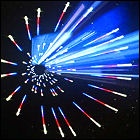 A few weeks ago, La-La Land Records released a definitive, long-overdue 3-CD edition of the soundtrack of 1979’s Star Trek: The Motion Picture, and you better believe I snapped a copy of that mother up – it’s my #2 favorite soundtrack of all time (next only to The Empire Strikes Back). Near the end of the third disc is a track isolating the sound of the blaster beam from the rest of the orchestra. Anytime in the first Trek movie you hear something that sounds like a cross between an electric guitar and the gates of hell opening, that’s the beam, baby.
A few weeks ago, La-La Land Records released a definitive, long-overdue 3-CD edition of the soundtrack of 1979’s Star Trek: The Motion Picture, and you better believe I snapped a copy of that mother up – it’s my #2 favorite soundtrack of all time (next only to The Empire Strikes Back). Near the end of the third disc is a track isolating the sound of the blaster beam from the rest of the orchestra. Anytime in the first Trek movie you hear something that sounds like a cross between an electric guitar and the gates of hell opening, that’s the beam, baby.
In isolating that instrument for a couple of tracks, they had to know that someone was going to do precisely what I did: isolate a single note and make a sample out of it that could be played.
I then started looking around for an appropriate song to “blast.” Just for fun. Just to see if the blaster beam had any viability as a rock instrument. (It wasn’t even originally devised as a complement to an orchestra – it was originally an avant garde new age instrument.)
The blaster beam has an extremely long decay, and any attempt to edit the sample down to reduce that sounds unnaturally cut off, even with a gradual fade. It has to be deployed sparingly. It can’t play every note of the song. The beam also makes different sounds: it can be “struck” for a sound that’s more percussive than tonal; I isolated that as well as a note and a glissando that starts at one note and slurs up to another.
Sadly, since I don’t have room in my house to build a 16-foot-long aluminum instrument using spent artillery shell casings, I’m limited only to what Craig Huxley played under the direction of Jerry Goldsmith on that track. I can change the pitch (and, as a side-effect, the duration) of a note, but I’ve got my three samples to work with and that’s about it.
Next: I had to find a song. I had to use something from the ’70s, just for authenticity’s sake (that was when the beam was in use), and it kinda needed to be something just a little bit epic. It wouldn’t hurt to hear it alongside an orchestra again, since that’s the context most people have for it. I started going through some ELO and Alan Parsons Project tunes last night and quickly realized that the Parsons stuff from that period was more dramatic and dark – a much better fit. I originally toyed with the idea of mixing some beam into I, Robot, but then went back to the Project’s first album and settled on The Raven – is there anything more epic/gothic/orchestral then a prog rock reading of Edgar Allan Poe? (Let me answer that for you: no, there isn’t.)
Again, knowing that it’d be easy to overwhelm the song with this weird, exotic sound, I tried to limit it to where it would be most effective and a bit shocking. I was also trying to be careful to avoid obliterating the vocals. Once the chorus kicks in, it’s actually pretty freaking awesome.
Listen here:
[audio:https://www.thelogbook.com/earl/podcast/ravenbeam.mp3]
Credit where it is due:
“The Raven” was written by Eric Woolfson and Alan Parsons, and was sung by Leonard Whiting (with Alan Parsons providing the vocoder vocals at the beginning). Orchestral arrangement by Andrew Powell. Recorded at Abbey Road Studios in 1975, produced & engineered by Alan Parsons. I used the original 1976 mix rather than the “enhanced” 1987 digital mix.
The blaster beam was sampled from the “Star Trek: The Motion Picture” soundtrack, composed & conducted by Jerry Goldsmith. The beam was performed by Craig Huxley, engineered by Bruce Botnick. I used samples from the track “Beams & Synthesizers for V’ger” from the 2012 remastered edition, and altered pitch and duration in Nero Wave Editor. Full mix done in Nero Soundtrax by ear (no BPM counter – it would’ve been useless with this song).
